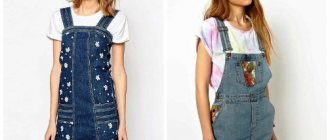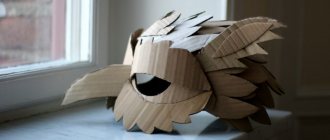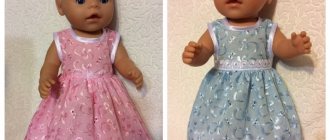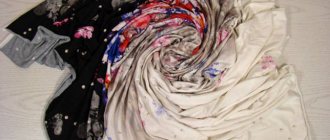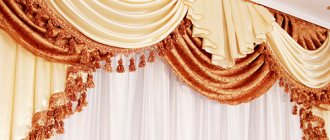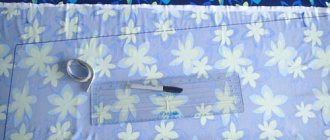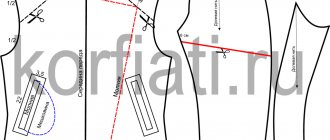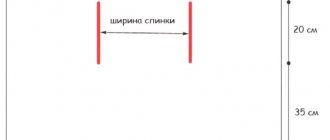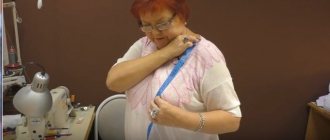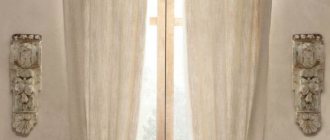A sundress is one of the most comfortable, practical outfits for girls. Summer, flared, double-sided, school, with a pleated skirt, warm, combined with openwork inserts, for babies and almost adult girls - there are a lot of model options. Sewing a sundress allows you to show your imagination and does not require deep knowledge, modeling and sewing experience. The patterns for these products are usually very simple. And sometimes you can do without them altogether. Now we will look at how to sew a sundress for a girl.
Sundress with contrasting trim
Patterns for a child:
- 1 year;
- 2 years;
- 4 years;
- 6 years;
- 8 years
- 10 years;
- 12 years old;
- 14 years old.
This is interesting: Sundress pattern for girls (size 6 months-4 years)
A simple model for a girl for a year
A light summer sundress with a minimum of details is an excellent option for beginners. Sewing it will take a minimum of time; it does not require additional decor. This is a beautiful model in which a girl will be comfortable.
The pattern is based on a trapezoid measuring 8 cm at the top edge, 22 cm at the bottom, and 21 cm in length. All that needs to be modified in the trapezoid to form armholes is to step back 6 cm from the sides and smoothly bring the lines to the side edges of the trapezoid.
Having cut out 2 parts of the base, they are folded face to face, then the side sections are ground off and processed on a machine. Having ironed the bottom seam allowance, a finishing braid is pinned to it. It is sewn on, the edge is overcast, then folded so that the braid is visible, and a finishing stitch is applied.
Armholes can be finished using bias tape. To prevent them from looking stretched when finished, when processing you need to slightly stretch the bias tape and make a barely noticeable wave of textiles. For convenience, it is better to use sewing pins. This results in a wide border on the reverse side.
A caveat: bias tape may seem capricious to a beginner. To make sewing a sundress evoke pleasant emotions, and not have to bother with the trim, you can change the processing of the edge of the armholes. To do this, you first need to iron the finished bias tape, folding it in half. It is much easier to sew it on with one line, putting the edge of the armhole inside.
Now all that remains is to fold the top edge of the sundress, stitch it and insert a satin ribbon. Fashionable new clothes for your daughter are ready!
Fashionable school suits for boys
A suit is not only elegant, but also practical. The student will be able to choose clothes depending on the season, and neither he nor his parents will have to worry about the compatibility of things. Trousers and a jacket are also an excellent option for a special day, of which there are many during the school year.
The trend is for single-breasted jackets with pronounced lapels, but the cut of trousers can be very diverse:
- free and straight along the entire length;
- tapered downwards;
- shortened (with or without cuff);
- with unusual details: elastic bands at the bottom, sports patch pockets.
Summer model for 2 years: master class for beginners
A mother who has an hour of free time can sew a cute sundress with straps for her daughter. Even a beginner can cope with sewing such a model. In addition, the measurements for the pattern are also minimal: you need the bust circumference and desired length.
Cutting details
The pattern is designed for a 2 year old girl. Having measured the circumference of the chest, add a small allowance for loose fitting, then divide the result by 2. The length of the bodice depends on preference. The approximate figure is 30 cm.
The top of the sundress will be double. Cut from fabric:
- 4 rectangles 16 x 30 cm (bodice), then the upper corners are beveled in a straight line by 5 - 7 cm, forming armholes.
- For the skirt, cut out 2 rectangles measuring 33 x 50.
- The straps are cut out 3 cm wide, the length depends on the individual child.
When cutting, it is worth considering a small nuance: without an allowance for a loose fit, putting on a sundress can cause difficulties.
Sewing technology
It's pretty simple:
- first prepare the straps by sewing them on a machine;
- The bodice parts are connected in pairs with right sides facing inward;
- Having outlined the correct position of the straps (at the very top corner of the armholes), they are placed between the paired parts of the bodice;
- the top blanks are stitched on three sides without touching the bottom cut, then turned right side out and ironed;
- the skirt parts are folded with the right sides inward, sewn down on the sides and the seams are processed using an overlocker;
- A narrow lace ribbon is sewn to the bottom edge, then the allowance is overcast and secured with a finishing stitch.
- Having aligned the skirt with the side seams, find the centers of the front and back;
- folds are laid from the centers of the skirt, distributing them symmetrically on both sides (for convenience, it is better to pin together the centers of the parts and the side seams of the top and bottom);
- the skirt is connected to the bodice, the edge is overcast (if desired, you can fold the seam allowance to the side of the bodice and secure it with a stitch).
The straps are tied when putting on the product. If the model seems rustic, you can decorate it with a small flower along the line where the bodice and skirt meet.
Modeling with cut-off waist
This model has a circle skirt style and straps. The pattern is designed for sizes 122-60. Any clothing size is determined by chest circumference. Chest circumference divided by 2.
The pattern must be drawn on paper or newspaper, following all the calculations, and cut out. The length of the strap to the sundress must be measured directly on the child before cutting. Here we will reveal a little secret to our mothers and grandmothers.
The length of the straps can be taken with a small margin so that they can be adjusted next year. It's very easy to do. You need to prop up the strap and take out the extra length, then sweep it up and sew it on.
Now let's start cutting and sewing. Place the finished patterns on the fabric. We lay out the bodice and skirt along the grain thread down.
The line of the middle of the back, front and fold of the skirt should lie in the middle (fold) of the fabric. Lay out the skirt as shown in the picture.
Trace the pattern on the fabric with chalk or a pencil along the outline and add seam allowances. The pattern on the fabric is cut along the seam allowance line.
Next we proceed as follows:
- Sew the bodice along the side lines. All open cuts on the product must be processed using an overlocker or zigzag stitch. With this operation, the fabric will not fray and the sundress will last a long time.
- Attach the skirt of the product to the waist line. Pin with pins (if necessary), sweep. Trying on a sundress with basting is required. This must be done to correct any inaccuracies before sewing. Only after fitting is the machine stitching done along the waist.
- Now you need to sew a zipper into the middle of the back. To make it convenient for a girl to take off and put on a sundress, it is recommended to take the zipper longer. The length of the zipper should also fit the skirt of the sundress.
How to sew a zipper correctly, watch the video:
- Fold the straps right sides inward and sew. Next turn it out. The seam can be ironed onto the middle of the strap, then the front side of the straps will look neat and beautiful.
- The place on the bodice where the straps are sewn needs to be covered with a facing.
- We fold the hem of the sundress using a hem seam with a closed cut using a machine or manually using blind stitches on the wrong side.
How to sew a children's sundress - instructions
Many novice seamstresses, due to the lack of a pattern, decide to go to the store and buy a new sundress for their daughter, rather than sew it themselves. But making a pattern is not a difficult task at all. Naturally, it’s impossible to find ideal patterns for different body types, but any mother can build a pattern based on her own measurements. Even for a sundress like the one shown below in the image.
Lush sundress
Construction of a pattern diagram
This model is suitable for girls from two to eight years of age. It is better to choose fabric made from natural fibers if you want to sew a sundress for the summer. Satin, chintz, silk, etc. are perfect. The colors are also selected individually to suit the child’s color type.
To build a diagram, you will need to take measurements:
- Half chest girth - PoG
- Half waist circumference - PoT
- Half neck circumference - PoSh
- Sundress lengths - DS
- Shoulder length - DP
- Length from shoulder to waist - DPT
Below is a diagram of the sundress pattern. The product can be sewn with or without pockets, sleeves. Next, we will consider a model without pockets or sleeves.
- Start building the diagram with the back part . To do this, draw a quadrilateral. Down from the point, set the length of the product from the shoulder to the waist. Set aside 1/2 PoH to the right side - build auxiliary lines in the form of a rectangle, then set aside 1/4 PoH from the top point of the rectangle, 7.2 is the length of the shoulder. Set aside 3.9 cm down from the resulting point to get a shoulder bevel and connect the points with an even line.
- According to your own standards, design 1/2 of the front part . Where 12.7 is 1/2 PoG, 5.7 is 1/2 PoSh, 7.2 is the length of the shoulder. And also cut out the lower part of the front. Where 14.7 is 1/2 PoG, and 11.7 + 4.5 = 1/2 PoT.
- After this, you can move on to cutting a full skirt for a sundress. It is presented in the figure as a quarter circle. 16.3 is PoT + 1 cm, 26.5 is the length of the sundress skirt.
Sundress for a little fashionista
You will also need to cut out bias tapes for finishing the neckline and armhole.
Instructions for sewing the product:
You will need tools and materials:
- Material for sewing the product - take the length of the product plus 15 centimeters
- Scissors, sewing machine, thread
- Satin fabric for the belt, snake.
Work process:
- Begin the process by transferring the pattern from paper to a fabric surface. Try to arrange the cut details sparingly so as not to waste material.
- When you draw the details of the sundress on the fabric, be sure to allow seam allowances, otherwise the item may turn out to be too tight for the child.
- Make sure that you have transferred everything onto the canvas correctly, only then cut out the parts of the sundress with scissors.
- The first thing to do is sew the top and bottom of the front.
- Then baste the zipper on the side seam, and sew the side parts of the front and back. Also sew the shoulder sections and overlock the edges of the product to prevent fraying.
- Sew the circle skirt in the waist area with a large stitch and slightly gather the seam so that it matches the size of the front and back.
- Sew the skirt to the top of the garment. Again, finish the seams with an overlocker, let the child try on the sundress, if everything fits in size, start processing the top, armhole and hem the bottom of the skirt.
- Make a ribbon from satin, and in the middle, so that the belt holds its shape, you can insert dubbing, etc.
The sundress is ready, in this outfit you can go for walks and to kindergarten. Below, look at patterns of sundresses that are suitable for school and everyday wear.
Sundress for a schoolgirl
Lush sundress
Taking measurements
For the school dress template and fabric calculation, you need to measure the girl’s height, chest, waist, hips, back width, length from shoulder to chest, as well as length from shoulder to waist and the size of the finished sundress.
Attention! For any style, you will need fabric equal to the length of the sundress with an addition of 15 cm for allowances. It is advisable to take more material so that you don’t have to buy more later.
Bottom decoration with lace
New look style for 8 year olds
Any girl will love this charming children's sundress with a fluffy skirt and bow. Sewing will not take much time: its complexity is minimized. First you need to measure the circumference of the hips, the distance to the waistline and the estimated length of the model. A gathering allowance is added to the hip measurement to make the bodice and skirt appear fuller.
Sewing the model is like this:
- Having cut out two rectangles, taking into account the allowances, they are ground down on the sides and the edges are overcast.
- The top edge is folded over to form a drawstring, after which two loops are made in front for threading a bow. In order for them to be reliable and not tear the fabric, the fabric where they are made needs to be reinforced with an adhesive pad. It is important to note that the width of the drawstring should cover the loops.
- The drawstring at the waist is secured with two lines: along the top and bottom edges. It is advisable to select threads for stitching to match the tone of the fabric, so the product will look neater. When making stitches, it is better to focus on the marks to the right of the presser foot, located on the metal plate of the machine. This will make the lines even and parallel. If you don’t want to bother with the drawstrings, you need to iron their allowances. This will allow you to lay the lines evenly and without preliminary basting. To prevent the stitching line from moving, it will be enough to secure it in several places with sewing pins.
- Having outlined the waist line (you can attach the product to the figure with the wrong side), sew on the drawstring, leaving room for threading the elastic bands (the width of the sewing seam is 0.1 cm). The drawstring around the waist should be solid, including going over the side seams. Having divided the width of the part into three parts, lay two more lines for the elastic bands, also leaving a small gap for threading.
- Having measured out the elastic bands of the required size, they are threaded and connected into rings. The gathers at the waist are distributed evenly.
- After shaping the waist, you need to complete the top of the sundress. To do this, take a satin ribbon and thread it through the loops, then cut off the excess length and carefully singe the ends of the ribbon. All that remains is to collect the straps and sew them to the top, without going beyond the top border of the stitching.
The model is convenient because it allows you to change the width of the top to make putting it on easier. This sundress looks stylish and beautiful.
This is interesting: Sundress pattern for girls (size 98-128)
Model patterns for teenage girls
It is a little more difficult for teenagers to choose a pattern. The thing is that the figure is just beginning to form, and each girl has her own way. However, even here you can simplify the task of sewing: when choosing templates for cutting, you need to start from four measurements: chest circumference, hips, waist and height.
They all matter. Even if you comply with the first three, but without taking into account the girl’s height, you can complicate the sewing process, because when calculating and constructing a lot depends on the height.
If the model is simple, such as flared or trapezoidal, you may only need the hip measurement. In this case, the pattern will look like a rectangle, which with the help of an elastic thread will turn into a fitted model. Moreover, making such a sundress is very quick and easy: having connected the side seams, finishing the bottom and top, you need to decorate the bodice with parallel lines with a distance of 1 cm (from the top to the waist line).
Another option is a pattern in the form of a trapezoid combined with a square at the base. The bottom of the pattern is rounded, the top is a straight line. To build, you need to measure the chest, hips and length. Allowances for loose fit must be added to the measurements. Having made a template, cut out the base of the sundress and the straps (two strips of fabric along the lengthwise).
Having connected the side sections and overcast them, they process the bottom of the product, and then proceed to the bodice. First, the armholes are folded and stitched, and then the top is folded in (separately the backs and fronts) and stitched. All that remains is to assemble the straps, insert them into the resulting channels of the top of the back and the shelves, tying them with a knot.
If you have a comfortable T-shirt, you can cut out a sundress using it. To do this, place the product on the fabric, outline the neckline and armholes with a pencil, and then draw a flare line. Such a sundress will be light and comfortable, and also fashionable. The only difficulty in sewing is processing the neckline and armholes with single facings. The trim will simplify the appearance.
Selecting a model by age
For first-graders, the day when they first enter the school building is very exciting. Therefore, you need to make sure that the child is dressed formally, but at the same time strictly.
You might be interested in this: Sewing a steering wheel cover for a car: how to sew on a cover
Note! To do this, you can purchase sundresses with different finishes in the form of ruffles, flounces, and decor. For first-graders, it is advisable to choose a dress with a skirt - sun, in the form of ruffles, A-line models and ruffles.
In recent years, fashionable sundresses with a fluffy tulle skirt and a transparent hem have been gaining popularity. Such products are often decorated with a bow at the waist, which adds solemnity to the style.
Acceptable product colors
For middle school girls, sundresses of any model will look great. Middle-aged girls choose what is comfortable to wear. A girl may like the cut or some individual elements of the sundress. But you need to remember that the older the child, the more classic style of dress she will choose. Older teenagers prefer strict and classic sundresses with a fitted and straight cut. The length is usually below the knees, or a little higher, but by no means mini.
When choosing a school uniform, you need to remember generally accepted guidelines. A school sundress should be a dark shade, without bright or shiny elements. Traditional tones for such clothes would be: gray - this shade is very friendly and combines well with other colors.
Uniform pattern with sun skirt
It looks good with shirts in blue, white, pink or purple. But, unfortunately, a dress of this color will be quite easily soiled. Burgundy is the brightest tone in the permitted color palette for school uniforms. It is advisable to combine it with a light-colored blouse. Therefore, it will be possible to highlight the richness of the product and make the outfit more aesthetically pleasing. Black - this color is quite elegant and classic. It slims and corrects the child's figure well. This dress goes well with shirts of any color and will be the most practical. Blue - a sundress in this color palette is well suited for everyday wear. For such a sundress, it is best to take light-colored shirts.
Pattern for fat girls
Children's sundress with buttons on the back
The main patterns for cutting can be drawn using the following drawings:
- for 1 year;
- for 2 years;
- for 4 years;
- for 6 years;
- for 8 years;
- for 10 years;
- for 14 years.
Sundresses with frilly straps
The frills on the straps look very delicate.
Patterns of sundresses are designed for sizes for girls:
- one year;
- two years;
- four years;
- six years old;
- eight years old;
- ten years;
- twelve years old;
- fourteen years old.
Dresses and sundresses for a child can be sewn without having in-depth clothing design skills. In addition, you probably will not need to buy material or order it in Moscow or another large city. If you have sewn clothes before, you probably have leftover fabric. By combining them, you can sew a sundress for a girl with your own hands using patterns or without them.
What material should you not take?
You should select fabric for a school sundress based on the following requirements for the fabric:
- The fabric should not be itchy, which means you should immediately remove wool from the materials in question. And don’t let her naturalness seduce her. It will be very rough and uncomfortable on the child's body.
- Debris should not cling to the fabric, and therefore velor, velvet and corduroy are not an option for school uniforms.
- The fabric must be wear-resistant, be it knitwear or dress fabric.
DIY school sundress
When a girl goes to school, you want her to be the best. It's no secret that choosing a uniform is more difficult: often a school sundress looks baggy, so it often has to be adjusted. For those who are committed to the ideal result, you can sew a sundress for school yourself. To do this, take as a basis a pattern from magazines or seen on the Internet on forums dedicated to needlework.
Unfortunately, it is not easy to find a high-quality pattern for a school sundress; its construction often confuses. But if you look closely at the templates, there is nothing overly complicated in them: you can make them yourself. For example, a skirt is a rectangular piece of fabric gathered into a fold. The bodice is a T-shirt with reliefs (side parts) extending from the armholes.
If the construction of a pattern is a dark forest, you can take a ready-made template designed for a suitable age. The main task is to print it in the required size. To do this, you need two measurements: the length from the back to the waist (exact) and the half-circumference of the waist (taking into account the allowance for a loose fit).
Having opened a Microsoft Word document, you need to insert a picture of the pattern into it and enlarge it to the desired size, measuring the parameters on the screen with a centimeter tape. If the girl’s figure is slightly different, you can slightly adjust the height. Since the template will not fit on the page, it is distributed over several pages, then printed and glued, aligning the edges.
The facings are cut out based on the details of the base: they follow the shape of the neckline, armholes, and are connected along the shoulder and side seam. Before cutting out facings, it is better to glue the fabric with non-woven material. This way they do not become deformed, unlike the method where the facings and glue are cut out separately and then joined together.
The sewing technology is as follows:
- Having cut out all the details of the cut (the shelf, the barrels of the shelf, two parts of the back, the barrels of the back, facings), they are assembled with a temporary stitch. Necessary fitting to avoid alterations. To prevent the neckline from stretching, you can baste facings to it.
- After fitting, the relief sidewalls and side sections are ground down. The edges are overcast (if the fabric is thick, the side seams are overcast separately, so that they can then be ironed and not create excess thickness when joining with the facings). The seams of the reliefs are ironed towards the center (shelf or back).
- Having noticed the folds (maintaining symmetry from the center of the front), they are ironed from the wrong side, then the skirt is stitched to the top. The allowance is overcast and ironed upward.
- Each middle section of the back is overcast, then a hidden zipper is sewn in (each side separately), using a special presser foot. Then the middle seam is sewn down.
- This product is somewhat different from simple sundresses, so you can’t do without the basics: the bodice is folded, combining the side seams, free shoulder sections and armholes (temporary stitching is removed). Having specified the symmetry, the shoulder seams are sewn down.
- The facings are sewn along the bottom edge, placing the face to the front side of the sundress, and stitched. Then they turn it inside out and iron it, fixing the shape of the neckline. This style does not need finishing stitches, as they will simplify it.
- The last stage of knotworking is the bottom edge. It is overcast, tucked and stitched. The bottom cannot do without a strong stitch: it is more reliable than hidden stitches. At the end of the work, the sundress is ironed, not forgetting the folds at the bottom.
Textiles used for sewing school clothes are very demanding when it comes to delicate ironing. WTO is performed only from the wrong side and through thin cotton fabric (or gauze). If you iron the product over the fabric, lacing will remain on it.
How you can sew a beautiful sundress without a pattern, see the next video.
School uniform for girls
Friday, March 07, 2014 05:51 (link)
Discussions regarding the introduction of mandatory uniforms for students have already died down. In most educational institutions, the need for a uniform is recognized by both parents and teachers. And therefore, if your school has already approved a single color scheme for the student dress code, it’s time to start the creative process.
A classic sundress is an almost irreplaceable item of school wardrobe, which is much easier to sew than a dress or jacket, and there are more options for combining it with blouses or turtlenecks.
| Tags: school uniform school sundress sundress for girls sewing a sundress pattern for a school sundress sewing patterns children's patterns | Comments (0)CommentIn quote book or community |
| Next 30 » | Pages: 2 3 …. 10 |
Double-sided sundress
For this model, two bright materials are combined or one of the sides is made of plain fabric. Using, for example, thin jeans looks very stylish.
To sew a sundress for a girl with our own hands we will need:
- fabric - two pieces of fabric, 0.8 m each;
- threads to match the color of the fabric;
- sewing tool.
How to sew
We start by making a life-size pattern.
One cell in the drawing corresponds to a square with a side of 1 cm.
The patterns are made for three sizes:
- from 1.5 years to 2 years (= height 86 – 92 cm);
- from 3 years to 4 years (= height 98 – 104 cm);
- from 5 years to 6 years (= height 110 – 116 cm).
The patterns are drawn taking into account allowances of 1 cm.
We cut out the parts from the first and second fabric - according to both patterns. There will be 4 blanks in total.
If we sew a sundress with pockets or appliqué, then we cut out blanks for them.
We process the edges of all workpieces around the perimeter using an overlock stitch or a zigzag stitch. Sew a pocket or applique (if provided) onto the front side of the front front.
We fold the blanks from the first fabric with the right sides and sew them together. Press the side seams.
We proceed similarly with blanks from the second fabric.
After you have sewn both parts of the sundress and pressed the seams, you can begin assembling.
Place one dress into the other with right sides facing each other and align along the cuts at the armholes and rollout.
Then we sew the seams along the armholes, straps and rollout. On the roll-out and armhole allowances, we make notches in several places so that the fabric does not pull when turning out. At the ends of the straps we cut off the allowances a little.
We turn the product right side out, sew the edge and iron it. We perform decorative stitching with a slight indentation from the edge along the line of the armholes, straps and roll-out. Hem the bottom edge.
That's it, the sundress is ready!
Dress code in a modern school
The modern school dress code for boys involves wearing:
- plain formal suits;
- light shirts (striped or checkered);
- sweater on top of shirt;
- bow tie or dark color tie;
- formal lace-up shoes;
- socks that match pants;
- black belt;
- You can wear a watch if you wish.
Pattern for a school sundress
Items of clothing that are best avoided:
- dirty shirt collar and cuffs;
- unironed items;
- cropped pants with sports socks;
- untucked shirts or underwear into pants;
- a sloppily tied tie;
- dirty shoes;
- jeans, T-shirts with patterns or cuts;
- sportswear;
- headphones and other accessories.
Model option for high school girls
Clothing for girls to school:
- classic suit or sundress, knee-length skirt or jacket in black;
- black or gray pants with arrows;
- a shirt in light colors, plain or with a neat geometric pattern;
- knitted turtleneck sweater in soft tones;
- ballet flats, boots or low-heeled shoes;
- thin nylon tights, or warm winter black ones;
- unpretentious jewelry (watches, earrings, hairpins).
Clothing that is not advisable to wear in an educational institution:
- various jeans with holes and T-shirts with prints;
- leggings;
- short skirts and shorts;
- short T-shirts above the waist;
- bright and subtle things;
- leather items;
- fishnet tights or stockings;
- stiletto heels.
Skirt with flounces
